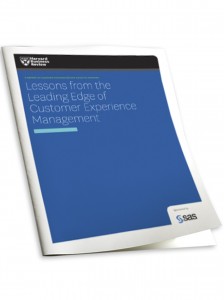Customer experience management is not a new concept, but it garners a lot of attention for one very good reason - it really matters. As typical consumers now have greater access to goods, services and information than ever before, it's never been more critical to differentiate. And for business models more complex than simple, high-volume transactions, differentiating on customer experience is increasingly an important driver of success across multiple measures.
 That was one key finding of a new study by Harvard Business Review Analytic Services that surveyed over 400 marketing executives from around the world and included interviews with a number of them.
That was one key finding of a new study by Harvard Business Review Analytic Services that surveyed over 400 marketing executives from around the world and included interviews with a number of them.
The report, titled "Lessons from the Leading Edge of Customer Experience Management," presents many valuable perspectives on how companies consider, plan and execute customer experience management initiatives.
One recurring theme of the report is how "leading edge companies" differ from the "laggards" across multiple dimensions. In fact, the report found that the leading-edge companies identified face the same issues around customer experience management as their peers, but
Leading-edge versus laggards:
where they differ is in how they respond to those challenges.
The part of the report I found particularly useful is where they lay out six steps that marketers can take to improve how they manage customer experience.
- Create a customer-centric culture
If your culture is not already oriented toward customer centricity, you're not alone. In fact, one opportunity the study revealed relates to tying reward structures to customer experience performance. Only 27% of respondents reported having such incentives in place, while doing that was rated by the respondents as more effective than any other single customer experience management tactic. The behavior you incent is the behavior you get - this is an opportunity for improvement.
. - Think like the customer
This is easier said than done, of course, but worth every effort. The main challenge for most organizations is the multichannel nature of how customers engage with the organization. So in order for each touchpoint to be right for the customer every time, the way to achieve that is to get everyone in the organization to think like the one common focal point that matters - the customer. The study found that the 3 best practices in this regard for leading-edge companies are to analyze all customer insights across the organization, to develop a customer experience strategy that aligns with corporate strategy, and to create consistent, company-wide customer experience standards.
. - Give the business control of the customer experience
This one reminds me of the externally-applicable notion that organizations are no longer in complete control of their brands. The proliferation of channels and the advent of social media has brought the customer right into the flight deck of the brand airplane. Internally, that means that more and more parts of the organization being engaged by customers, creating multiple potential impacts on customer experience. One Director of Customer Experience interviewed for the study believes that everyone in the business plays a key role in effective customer experience management. Put the spotlight on it and bring all relevant internal players into your customer experience management process.
. - Tame channels and data
On this one, it's the external channel explosion that prompts the need for awareness of your internal channels. This speaks to the need for awareness of how organizational siloes and legacy processes can affect the customer experience. While giving the business control of the customer experience may be important, doing that also requires cross-departmental orchestration. And since every organization has its own set up and advantages/challenges, I think how this plays out depends on the particulars of your own organization. Alas, there's no magic formula for this one.
. - Embrace analytics
Here is where the channel explosion, the tsunami of unstructured and structured big data, and the potential data siloes (that match organizational siloes) come to roost. And here is where the leading-edge companies' embrace of analytics is a clear differentiator in how they are responding to customer experience management challenges versus the laggards. By a consistent factor of almost three to one, leading-edge companies are more effective in their use of analytics across several dimensions, and they recognize the importance of emerging analytics technologies, including ones for online behavior, social media sentiment, and text, as well as tools that can deliver real-time analysis of large data sets.
. - Expand the definition of customer experience success
Most organizations have trouble tying customer experience investments to business outcomes. And while customer satisfaction scores are widely used in all companies surveyed, they alone are not enough. In fact, leading-edge companies measure success with a wider variety of factors - across the board over twice as likely as the laggards to use such metrics, like customer lifetime value, indirect traffic, social media sentiment, and upsell rates.
What's clear is that leading-edge companies are capitalizing on opportunities that come from every interaction they have with their customers over the duration of the relationship. They are undeterred to the challenges they might face and seem to approach customer experience management as a business priority and not a "departmental" problem to be relegated to customer service or marketing to worry about. To these leading edge companies, customer experience management really matters - and it shows.
And these six lessons are not even the half of what's in this report. Want to know more? Download the report here:
Lessons from the Leading Edge of Customer Experience Management
I promise it worth the effort to register and read. Let me know if you disagree.
Thanks, as always for following!
